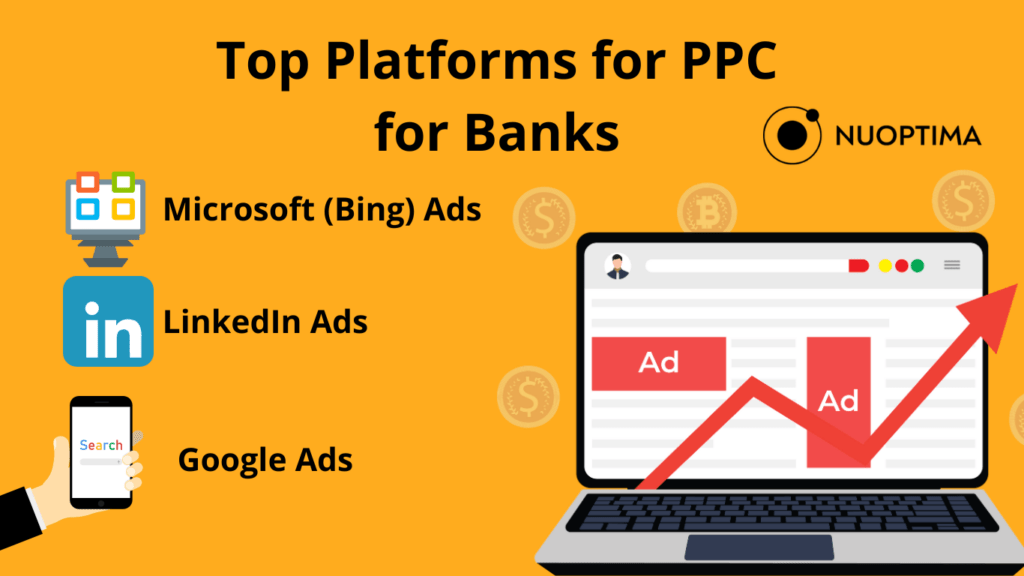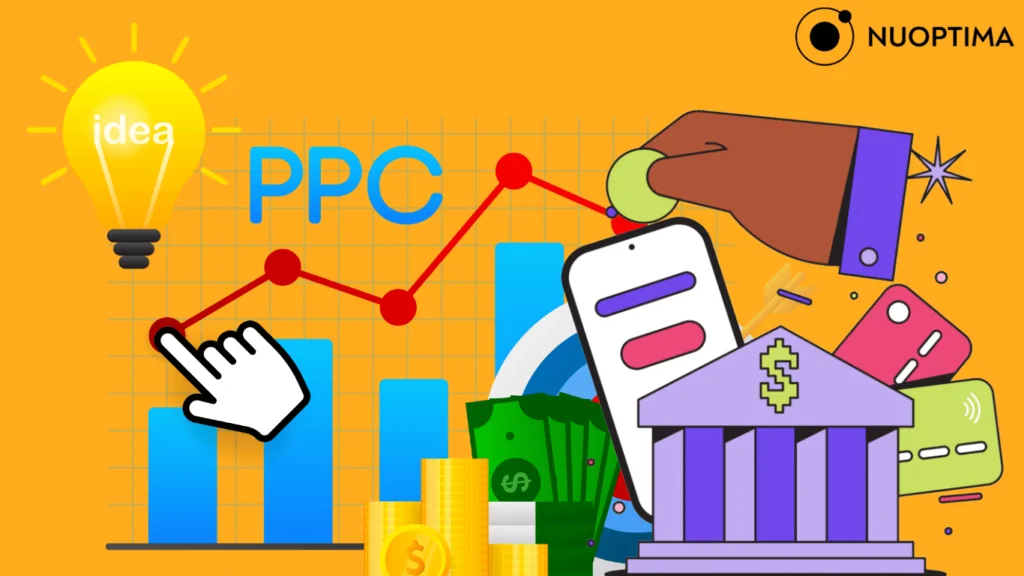The private banking sector has been growing for the past few years and will not stop anytime soon. In 2024, it’s estimated to be worth nearly $89 billion; in the next five years, that number could grow to $143 billion. [1]
More financial institutions are out there than ever, so if you want to stand out, you must advertise your business properly… And if you’re new, you must do it cost-effectively, too.
That’s one of the main reasons Pay-per-click advertising has become so popular in the banking industry. Nearly three-quarters of brands say that PPC is the driving force for their business.
Let’s look at PPC for banks. We must define it, look at its biggest benefits, and discuss how to create your first campaign. Below, you can also find our interactive calculator to evaluate the potential profitability of this approach. But first…
What is PPC for Banks?
Pay-per-click (PPC) for banks is a paid marketing strategy for financial service companies. In PPC, you select an advertising platform, create ads, set your target demographic, and launch a campaign for a certain amount of time.
The amount of money you spend depends on the effectiveness of your ads because, in PPC, you only pay the publisher when a person clicks on an ad. There are different types of PPC ads, including display ads, social media, and retargeting ads. Every single one of these ad types has its benefits. The choice depends on your goals.
After referrals, PPC is the most effective advertising channel in the finance industry. The average conversion rate in the PPC industry is around 6%[2], which is quite high.
Key Benefits of PPC for Banks
Did you know that 8 out of 10 marketers[3] say that PPC has hugely benefited their business? Well, Hanapin Marketing’s survey of over 400 marketers claims just so. You might think this sounds great, but how can PPC help your organization? Let’s look at some of the biggest benefits of PPC for banks.
It’s as Easy as Tapping Your Phone Screen
If you’ve done PPC marketing, you don’t need to spend weeks watching tutorials. After a tutorial or two, you can learn the interface of any popular PPC platform in a few hours.
Besides that, you can see results from PPC relatively quickly. Strategies like SEO require months of work and build-up before any results can be seen. You can turn a PPC strategy on and off in just a couple of clicks.
Nearly two-thirds of people have clicked on a Google Ad before[4], so your target audience is familiar with these advertisements. Write an attractive copy, and you’ll get new leads in no time. If you’re looking for expert assistance in creating optimized ads, consider working with a Google Ads agency to get the best possible results and reach your target audience more effectively.
You Can Test As Many Ads as You Want
On the same note… How can you be sure what ads attract your target consumer base? Of course, you can check out your competitors, see what works for them, and take a few cues.
However, to nail your PPC campaign, you need some hands-on experience. You probably won’t create a perfect copy that attracts thousands of leads instantly. But the most beautiful thing about PPC is that you don’t have to pay for it.
PPC platforms provide analytics to refine your ads in real time. You can see if an ad is giving you worthwhile returns. If not, you can change it. Simple as that.
You Just Pay for Users That Click on Ads
We’ve mentioned this previously, but let’s go over it once more, quickly. Certain platforms out there—cough, Amazon[5], cough—still use the cost-per-impression model, where you pay per 1,000 impressions your ads receive.
But most PPC platforms won’t charge you anything until your impressions become actual clicks. That way, you don’t have to worry too much about your initial copy. You can focus on tweaking your budget, keywords, or landing page to improve conversions.
Gives You Amazing Targeting Options
The Google Display Network reaches 90% of Internet users[6] so that you can reach your target audience regardless of their identity or location.
Many marketers take a multi-layered approach to PPC, which allows them full coverage across Google’s networks. How does this multi-layered approach look? In simpler terms, advertisers use different strategies simultaneously to reach a wider audience. Strategies such as:
- Targeting broad keywords via responsive search ads;
- Running display ads on popular websites through remarketing based on past user behavior;
- And advertising to specific demographics through display networks like Google Maps, YouTube, and Gmail.
By mixing these advertising methods, advertisers can see what types of ads get the most views and what strategy to focus on in the future.
Works Great With Other Marketing Strategies
Speaking of a multi-layered approach… Let’s talk about how PPC works with other marketing strategies.
SEO is a core element of any digital marketing strategy. Its main goal is to boost your rankings in SERPs and attract more people to your website. By analyzing PPC keyword impression data, you can easily discover what keywords are popular among your target demographic.
That’s just one way PPC can help you with optimization. There are lots more. At NUOPTIMA, we also do SEO for fintech companies and handle entire growth campaigns for them. This requires us to combine SEO and PPC strategies to get the best results.

Top Platforms for PPC for Banks
Now that you know the potential benefits of PPC for your bank, let’s quickly discuss a couple of popular platforms you can use. The choice heavily depends on who your target audience is and where they spend time online. These platforms are good options for banks and other financial industry businesses.
Microsoft (Bing) Ads
While Microsoft still owns a small percentage of the overall search engine market, PPC ads on Bing might be worth it. For one, Microsoft did report an 8% jump in search and news advertising revenue[7] in the last quarter of 2023, so advertisers are taking the platform more seriously.
You should also take into account who uses Bing[8].
The average age of a Bing user is 45, over 50% of its users are college-educated, and a third have a household income of at least $100,000. All these facts make the average Bing user a great demographic for financial businesses.
LinkedIn Ads
LinkedIn is a social media network for professionals, and many B2B businesses advertise on it. But you can also use it. Research shows that LinkedIn is the second most trusted platform among financial advisors[9]. My banks and credit unions already advertise on LinkedIn because the users trust it so much. So why not give it a try?
Google Ads
Probably the best PPC platform for your bank is Google Ads, the largest PPC platform. Over 77% of Google’s revenue comes from ads, so they continuously improve their services. This ensures your bank has access to the most effective tools to reach potential customers.
Also, consider the fact that a quarter of users[10] click on the first search result – whether it’s organic or not. So, if you target the right keyword, your ad can potentially have a great CTR.
One thing that might be on your mind is, how is running ads on Google worth it when consumers can search for a bank directly? It is worth it for one reason: on average, Google Ads convert 50% better than organic results on Google[11].
Best PPC Keyword Research Tools
Before getting to the meat of the article… Let’s quickly look at some of the best tools for PPC keyword research. We’ve included paid and free options, so no matter your budget, you can find a tool for your needs.
Google Keyword Planner
Sometimes, it’s best to go right to the source to research PPC keywords… With Google’s Keyword Planner, you’ll get data directly from Google, so you can rest assured it’s accurate. The Keyword Planner is also free to use and there are no hidden costs. It has a relatively steep learning curve, so for a beginner, it might feel a little overwhelming.
Ahrefs
Ahrefs has been the industry standard for many years when it comes to keyword research. Over 6,300 businesses use Ahrefs[12], and while the tool is more geared toward SEO, it gives you plenty of PPC data. It allows you to organize your keywords into lists, arrange them, and export them to your device. The only downside is the high price, which may present an entry barrier for new and small businesses.
Keywords Everywhere
Lastly, we have a simple but effective Chrome extension that shows you keyword data right there in your Google SERPs. All you need to do is enter a keyword you want and it will give you information on search volume, cost-per-click, and competition. If you’re a beginner, it’s maybe best to start researching with Keywords Everywhere before moving on to more expensive or complex tools.

How to Optimize Your Bank’s PPC Strategy
Simply finding a couple of relevant keywords, having ChatGPT write your ad, and launching your campaign won’t cut it. If you truly want your bank’s PPC campaign to succeed, you must plan and optimize it. To help you get the desired results, here are seven easy steps to optimize your bank’s PPC strategy.
Research Your Competitors
Before you can launch your PPC campaign, you have to do your due diligence. Identify 3 to 5 competitors in your niche and analyze their PPC content. You can use Ahrefs to see what keywords your competitors are bidding on. Then, you can select around 10 to 15 keywords to target.
If your budget is modest, then you should select keywords with low cost-per-click or CPC. However, remember that low-cost keywords might not get you the quality leads you want. If a high-CPC keyword is relevant to your banking service, it will undoubtedly send more quality leads your way.
Once your keyword list is created, you need to enter them one by one in Google and examine the ads on the first page. It would be best if you took note of the following:
- The copy and the tone used
- What the company is offering
- What is their price point
- How their landing page looks
With that knowledge, you can create ads that are similar in tone, describe everything you offer in short, concise text, and still be different from your competitors’ pages.
Calculate Your Costs Carefully
We keep talking about the potential costs of your PPC campaign for a good reason. Regarding PPC for banks and other financial services, the costs are high compared to other sectors. Here’s how the average CPC costs[13] stack up in some of the major industries:
| Industry | Average CTR (Search) | Average CTR (GDN) |
| Advocacy | $1.43 | $0.62 |
| E-Commerce | $1.16 | $0.45 |
| Finance & Insurance | $3.44 | $0.86 |
| Real Estate | $2.37 | $0.75 |
| Technology | $3.80 | $0.51 |
This is just a reminder that the numbers in the table above are just your average costs. For some keywords, the price may be much higher, Especially if they indicate high conversion intent.
Of course, the costs of CPC will be covered by new conversions if you manage to generate a solid number of quality leads. Nonetheless, you need to be careful when calculating the costs.
Carefully Select the Target Keywords
Let’s discuss broad-match keywords. Broad match allows Google to present your ads to anyone even remotely interested in your content.
Here’s an example: let’s say you’ve added the broad-match keyword “banking services near me.” not only will your ad be shown to people looking up the exact term but also to people looking up things like “banking jobs” and “banking salary.”
In reality, people looking up baking jobs and salaries won’t be interested in your services. Google’s algorithm isn’t advanced enough to grasp that. People looking up these keywords either won’t click on your ads or they’ll click on them by accident, increasing your CPC costs with no gain.
Initially, you should focus on the phrase match and exact match. That way, you’ll have much more control over who sees your ads and who doesn’t. And whatever you do, never apply the auto-recommendations Google gives. You’ll end up draining your PPC budget without gaining basically anything.
Add Negative Keywords Too
Continuing with the theme of keywords, let’s talk about negative keywords for a moment.
The phrase “negative keywords” refers to words and phrases that prevent your ads from showing in irrelevant searches, saving your budget in the process. For example, to avoid job seekers, you might use “bank jobs” or “bank careers” as negative keywords, ensuring your ads reach potential customers instead. In this case, adding negative keywords will:
- save you money wasted by job seekers who’d click accidentally on your ad;
- nd help you enhance the quality of website traffic that your ads attract.
We’ve actually written about negative keywords in the past. If you want to know more about them, we recommend reading the article linked here.
Create Custom Landing Pages
While it may seem time-saving to have your ads drive traffic to your homepage or one of your service pages, in the long run, it may prove smarter financially to create a landing page for every ad campaign you launch.
According to research, business websites with 10 to 15 landing pages have 55% better conversion rates[14], and the ones with over 40 achieve 500% better conversions.
Here are some of the benefits of having a dozen or more landing pages:
- You can optimize the landing page, add keywords, and improve your Google score.
- Also, you can add a submission sheet or several CTA buttons to increase the chances of converting leads.
- And, you can more easily A/B test different copies, graphics, and page structures to improve conversions.
Don’t worry – you don’t have to create a COMPLETELY NEW landing page every time. You can duplicate one of your service pages and make a couple of tweaks. That will save you a couple of dollars in the process.
Create a Lead Scoring System
Not all leads are created equal. To determine how good leads your ads attract, you need to implement a lead scoring system. This will save you time by ensuring that your leads are actually worth pursuing.
How do you score leads? By determining how close someone is to converting into a customer. Your marketing efforts will be much more efficient and your customer acquisition team won’t waste any time trying to convert leads that aren’t all that interested.
Here are three major lead types that can help you create a scoring system:
| Lead Type | Information-qualified leads | Marketing-qualified leads | Sales-qualified leads |
| Also Known As | Cold cases | Lukewarm leads | Hot leads |
| Buyer Journey Phase | Early-stage (awareness phase) | Exploring solutions (consideration phase) | Near purchase (decision phase) |
| Possible Interactions | Limited website interaction | Frequent site visitors, often reviewing resources like case studies and whitepapers | Consistent site visits; may have scheduled a demo or accessed pricing details |
“Run Your Own Experiments”
When it’s all said and done, the best advice we can give you is to start your campaign, test it as much as possible, and then improve it until you’re completely satisfied.
In a 2022 webinar, Google Ads specialist Miles McNair explained that you can’t blindly follow other people’s advice. Just because something worked for someone else doesn’t mean it will work for you.
As he said, “Run your experiments to find what works for your business.”[15]
A/B testing should be a crucial part of your strategy. Here are a couple of things you must test:
- Ad copy – Everything from headlines to extensions must be tested.
- Landing page – Body text, CTAs, and keywords all should be checked.
- Ad timing – If you do not see good ROI on ads during the weekends, for example, you can turn them off.
Conclusion
If we had to narrow it down to a single reason, we would say that PPC advertising in the financial sector is popular because it gets results. You can easily implement it into your overall marketing strategy; it will attract more leads and, after a while, generate more revenue.
With PPC campaigns, you have an opportunity to reach your targeted audience, increase brand visibility, and drive traffic to your website. If you’re interested in PPC for your financial institution, book a call with our specialists and find out more about our offerings.
Book Call
Start your growth journey today.
FAQ
PPC or pay-per-click is a digital advertisement method where businesses pay a fee every time their online ad gets a click.
The cost-per-click is about $0.86 for display ads and $3.44 for search ads, but it isn’t only the competition which drives up the prices. There are other factors like:
- High customer lifetime value (CLV)
- Complex and regulated industry
- Targeting high-value transactions
- More informed and selective audience
PPC is a great method for B2B companies to gain more customers. It allows them to target specific industries, job titles, locations, or other relevant criteria.
Facebook Ads and Google Ads are the paid ad channels with the highest reported ROI.
References
- https://www.mordorintelligence.com/industry-reports/united-states-private-banking-market[1]
- https://www.ruleranalytics.com/blog/reporting/financial-services-marketing-statistics/[2]
- https://www.ppchero.com/new-research-the-state-of-ppc/[3]
- https://www.demandsage.com/google-ads-statistics/[4]
- https://advertising.amazon.com/library/guides/cost-per-mille#:~:text=CPM%20is%20a%20pricing%20model,a%20monthly%20or%20quarterly%20basis.[5]
- https://www.thinkwithgoogle.com/intl/en-145/future-of-marketing/digital-transformation/google-display-network/#:~:text=What%20is%20it%3F,1%20billion%20users%20every%20month[6]
- https://searchengineland.com/microsoft-search-news-advertising-revenue-q2-2024-437044[7]
- https://www.wordstream.com/blog/ws/2019/11/19/who-uses-bing-anyway[8]
- https://business.linkedin.com/marketing-solutions/financial-services-marketing[9]
- https://www.searchenginejournal.com/google-first-page-clicks/374516/#close[10]
- https://www.powertraffick.com/google-ads-statistics[11]
- https://mycodelesswebsite.com/ahrefs-statistics/#:~:text=Ahrefs%20is%20active%20in%20243,involved%20in%20marketing%20and%20advertising.[12]
- https://www.wordstream.com/blog/ws/2016/02/29/google-adwords-industry-benchmarks[13]
- https://blog.wishpond.com/post/89066037410/how-many-landing-pages-do-i-need-on-my-website#:~:text=Studies%20have%20shown%20that%20business,increase%20conversions%20by%20over%20500%25.[14]
- https://lunio.ai/blog/paid-search/google-performance-max-campaigns/[15]


